



article by author Mr. Darko Zubrinic, Zagreb (1995), Source: from website Croatian history.net - Croatian mariners in the New World; Croatian Guilds and Collegiums
The oldest known Croatian Guild of merchants in Italy was founded in 1375 in the city of Recanti - Faternitas Sclauourm Sancti Petri Martiris. According to Venetian archives, nearly 20% of the eastern part of the city of Venice called Castello was Croatian. Even today there are streets, squares, passages, bridges and churches in Venice that bear witness of the presence of Croats during many centuries, most often in the name of Schiavone, Brazza (= the island of Brac), Lesina (= the island of Hvar) etc. For more details see an article by Lovorka Coralic in Croazia/Italia.
____________________________________________________________________________________
Croatian coat of arms (on threecolor flag), on the left mast of the Enrica brig, built in Rijeka in 1868
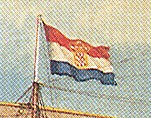
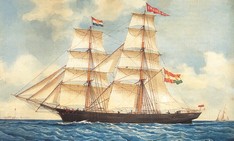
The Croatian Guild of St Juraj and Tripun founded in 1451 (Scuola dei SS Giorgi et Trifon, also called Scuola degli Sciavoni, Scula Dalmata, Scula nazione Illirica) had its site in the Church of St Giorgio and Trifon. It possesses valuable paintings of V. Carpaccio. The Guild is active even today. Many Croats from Boka Kotorska (annexed to Montenegro in 1945) were also its members.
In the church of S. Pietro di Castello on the islet Olivolo in Venice, there are interesting traces of close ties with Croats:
The Guild of St. Jerome in Udine was founded in 1452.

Very important Croatian Congregation of St. Jerome in Rome was founded in the beginning of the 15th century, and already in 1453 had its church in Rome, with the associated hospital and guest-house for pilgrims, refugees and exiles from the Croatian ethnic areas occupied by the Turks. It is interesting that besides the Latin Mass also Glagolitic Liturgy had been served regularly in the Church of St Jerome, with the use of Glagolitic missals and breviaries. The congregation exists even today, under the name of Croatian Papal Collegium of St. Jerome. The name was given by a rescript of Pope Paul VI in 1971.
Also very important in educating our students was a Croatian Collegium in Bologna (1553-1781), founded first as Collegium Hungarica - Illyricum, then soon Croatized, as Hungarians had their own Collegium Hungaricum in Rome since 1578.
Collegium Illyricum in Loreto was founded in 1580, intended to educate Croatian youth, with 30-36 students. It was acting with interruptions until 1860. During three centuries about 1,000 Croatian students were educated there. The most outstanding of them was Bartol Kasic (1571-1650), author of the first Croatian grammar (Rome, 1604).
The earliest known description of a sporting event in Croatia is from the 16th century. It reffered to the 1593 regatta of seventy four (yes, 74) wooden fishing boats called falkusa (Croatian: falkuša), from the harbour of the town of Komiza on the island of Vis to the islet of Palagruza. It was the oldest known boat race in Europe. Falkusa is autochthonous Croatian boat of 9m of length, with the mast of equal size, in use from 11th or 12th century until the middle of the 20th century. A crew was composed of five rowers, and the marathon covered 42 miles, for which about five to fifteen hours of continuous and exhausting rowing was necessary, depending on weather conditions.
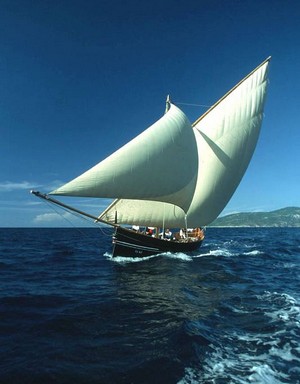 Falkuša / Falkusa, autochthonous Croatian boat from the town of Komiza, island of Vis
Falkuša / Falkusa, autochthonous Croatian boat from the town of Komiza, island of Vis
The very start of the marathon of the armada was announced by a cannon from the Renaissance tower in the Komiza harbour early in the morning of 20th May. One can imagine the foam raised by 74 boats and 370 rows in the harbour! The description of this interesting event is kept in the Liber Comissiae in the parish of the town of Vis on the island of Vis. In 1998 falkusa was included into the UNESCO World Heritage List. See Prvi zapis o Palagurskoj regati (in Croatian), Gajeta Falkusa, Vis (in Polish), The Falkusa.
____________________________________________________________________________________
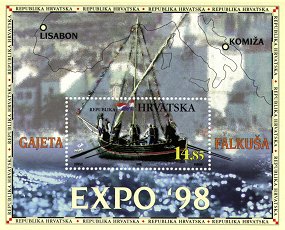 A Croatian falkusa sailed from Komiza to Lisabon to be exhibited at EXPO'98, where Croatia was the greatest surprise. Postage stamp designed by Danijel Popovic, Zagreb.
A Croatian falkusa sailed from Komiza to Lisabon to be exhibited at EXPO'98, where Croatia was the greatest surprise. Postage stamp designed by Danijel Popovic, Zagreb.
The next earliest known description of a sporting event in Croatia is from the 18th century (1764). It referred to the regatta of two fishing boats representing the cities of Split and Makarska, from an islet near Milna on the island of Brac to the Split harbour. It was the Makaran boat that triumphed!
One of truly fascinating exploits in which Croatian mariners participated is related to ARCTIC EXPEDITION in 1872-1874, organized by the then Austrian-Hungarian Empire. The Croats at that time had the status of Kingdom within the Empire.
The name of Ragusa (=Dubrovnik) and St Vlaho, patron of Ragusa, and also other Croatian names appear on old maps of Central America already in the 16th, soon after discoveries of Cristophor Columbus, John and Sebastian Cabot. Capo de Arause appears on John Cabot's map (15th century) between New York and Cape Cod. Arase was a corrupted Spanish, Portuguese and Italian pronunciation of Ragusa (Dubrovnik).
Some of Sebastian Cabot's mariners were Bozo de Araguz (from Ragusa), Stephen de Lezna (= Lesina = Hvar, Croatian island), Stephen de Arva (= Arbe = island of Rab). According to Adam S. Eterovich about 20 percent of S. Cabot's crew was Croatian.
Croatian mariners organized a chapel of Saint Vlaho in the Church of Santa Maria di Castello in Genoa in the 1400's. The name of Ragusa has many variations: Aragoso, Arause, Araguz, Rhagusi, Ragoza, Rausa etc. Also the name of St Vlaho, patron of Ragusa (Dubrovnik): Bigio, Blaas, Blas, Blaise, Blaze, Braz, Bras.
In the area of Panama there is an Otoque island (otok = island in Croatian!), close to the Pacific side of the Panama canal. In the same area there is Saboga island (sa Boga = za Boga = for God). More to the south there is Punta Mala (mala = small in Croatian, i.e. a small point). In the Panam area the name of San Blas (= St Vlaho, patron of Ragusa) is mentioned several times: San Blas Point, San Blas Bay, San Blas Mountains.
Sebastian Cabot also traveled to Brazil, Uruguay, Argentina and Paraguay. His map of the voyage to the Rio De La Plata in 1526-30 has a bay Mime Ragoso - or "just like Ragusa", which is in Brazil! It is interesting that ship's officer on this voyage was Matias Mafrolo, who was Slavonian, i.e. the Croat.
An important discovery of Adam S. Eterovich regarding the Croats in the New World covers several obviously Ragusan names of mariners in the famous Columbus crew in 1492: Martin de Araguis, Pedro de Arague. For more details see Eterovic, p. 32-38.
It is a fact that Giovanni Verrazano gave also Dalmatian and Croatian names to various toponyms in the New World during his voyages along the Atlantic coast of New England, New York, the Carolinas, Florida in 1523-1524 (Malabrigo, S. Blas, Mala gente, Costa do Brada, Golfo di Castelli, Fiume, Brioni etc.). In a book by Jacques Habert on the Voyages of Verrazano a chapter heading is entitled "La Dalmatie de Nouveau Monde", 1964 (Dalmatia of the New World), in a book by Carlos Pazzini we have "La Dalmazia Del Nuouvo Mondo", The American Scenic and Historical Society in a description of the American coast has a heading "Dalmatia of the New World", 1910. According to Adam Eterovich, the fact that Verrazano has no geneaology in Italy or France seems to suggest to seek his roots in Dalmatia, not in Italy: Giovanni -Ivan, Verrazano - Veratius, Vrantzius, Vranyczany, Vranjanin, Vrancic. The nobility of Europe always maintained very detailed and accurate geneaologies for rights of title, succession and property. E.G. Tudor in his Tudor Geography (1934, London) states: "A majority of the mariners and the pilots on the king's ships at this period were foreigners - Ragusans (listed first), Venetians (mostly our "Sclavonians", since Dalmatia at that time belonged to Venice, and represented about 70% of its entire territory), Genovese, Normans and Bretons". This was noted by the French Ambassador Marillac in 1540. See Adam S. Eterovich's "The Verrazano voyages to America and Canada 1523-1524", Croatia in the New World, Ragusan Press, San Carlos, USA, 1990.
There are very strong and convincing indications that even Marco Polo, Marco Polo was a descendant of the Croats (Marko Pilich).
Many of the early European expeditions to the western shore of the Atlantic finished with shipwrecks. So was the case with some ships from Dubrovnik in the 16th century. It is interesting to mention that the Croatan Indians in the USA could possibly be the descendants of the saved Croatian crew, as authenticated by their name, brown hair, blue eyes and some of the words in their language. Two large islands appear on the Molineaux map of Virginia, USA (1599), with the names Croatoan and Croatamonge (see Eterovic, p. 30).
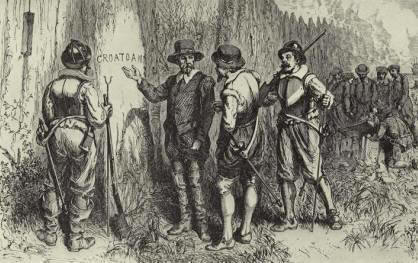
An American writer John Lawson in his 1714 chronicle wrote that among Croatan Indians of that time there was a legend of a 16th century shipwreck with mariners who saved themselves and stayed with Indians.
See also: Croatoan Indians: Trace of the legend of Croatians in North Carolina, USA (on the Geni).
In attempts to find Walter Raleigh's Lost Colony inhabited by the British Empire in 1587 on the island of Roanoke (near the Croatoan island, North Carolina, USA), the searchers found a CRO carved in Roman letters on a tree in 1590. Another big tree had a bark peeled off, and carved on it in capital letters was the word CROATOAN. For more information see CROATOAN – The "Lost Colony" of Roanoke, written by Ivan Marjanovic De Tonya (Croatian American poet and author).
It is indicative that a (French?) lexicographer and maritime historian J. Jal included in his Glossair nautique about 500 original Croatian maritime terms.
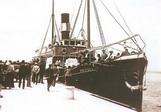 Steamship Hrvatska (Croatia), 1904 (from R.F. Barbalic, I. Marendic: Onput, kad smo partili, MH Rijeka, 2004, with permission of Mr. Darko Dekovic)
Steamship Hrvatska (Croatia), 1904 (from R.F. Barbalic, I. Marendic: Onput, kad smo partili, MH Rijeka, 2004, with permission of Mr. Darko Dekovic)
One of truly fascinating exploits in which Croatian mariners participated is related to ARCTIC EXPEDITION in 1872-1874, organized by the Austrian-Hungarian state. See also: Croatian mariners in the famous Arctic Expedition (1872-1874.): The discovery of Franz Josef Land
Captain Mate Dulcic Hraste-Pucetov from the island of Hvar obtained a silver jug from the British Governement as a recognition for saving the boat "St. Croix". Gilted inside, 14.5 cm high and with diameter of the opening of 8.5 cm, the jug bears the the following inscription see [Mate Milicic et al., p 68]:
Presented by the British Government to captain Matteo Dulcich Hraste of the "Giovanni D" of Jelsa in acknowledgement of his humanity and kindness to the shipwrecked crew of the "St. Croix" of Jersey, 27 September 1877, abandoned at sea.
Captain Marko Vekarich, Master of the Austro-Hungarian Barque "Isaac", received the following letter from the Government of Canada for saving the shipwrecked crew of Canadian ship "Angle" in the Atlantic (the letter is kept in the town of Orebic, Peljesac peninsula near Dubrovnik):
OFFICIAL SEAL MARINE OF FISCHERIES
Ottawa, 12th February 1879
Sir
Her Majesty's Government having brought under the notice of this Department the circumstances connected with the wrecke of the "Angle" of St. John, New Bruswick, and the services rendered by you, as Master of the "Isaac", to the shipwrecked crew, it affords me much satisfaction to convey to you the thanks of the Government of Canada and to request your acceptance of the accompaning gold watch, which has been awarded in recognition of you human and generous services.
I am, Sir, your most obediant servant James C. Voke Minister of Marine etc.
In 1861 captain Jozo Šunj (Sunj) from Orebic (Peljesac peninsula), Master of the Barque "Nicolo Despot", obtained official recognition and gold chronometer with engraved dedication from Abraham Lincoln, president of the USA, for having saved the crew of the USA sailor "Homer" in the Atlantic.
Society for building and exploitation of long range navigation vessels (later Maritime Society of Peljesac) in Orebic was founded in 1865. In 1873 the Society had 90 great and nice vessels with total weight of 45000 tons, with 2000 employed, out of which 250 were captains. The Society existed until 1891.
____________________________________________________________________________________
The Hrvat (Croat) steamship, the first Croatian steamship, was built in the Rijeka Technical Factory (Stabilimento tecnico fiumano) to plans by the Rijeka engineer Otto Schlick and launched on 13th July 1872 as the first ship of its kind built on the Croatian coast for a domestic customer. It was ordered by the Shipping society from Senj that intended to establish a line of passenger and cargo ships between Rijeka and Senj. The ship was made of iron, was 34.65 m long and 4.80 m wide, and powered by a 130-horsepower steam engine. It had a capacity of 82 gross register tons and a crew of nine. Regular passage between the two harbours was established on the 7th September of the same year. Initially it sailed five times a week in summer and three times a week in winter, with stops in Novi Vinodolski, Selce, Crikvenica, Voz, Kraljevica and Bakar. The ship sailed under the flag of the Ungaro-Croata shipping company. It was sold in 1903 in Mali Lošinj where it was renowned, and resold to Izola under the name of Besenghi. It disappeared from the list of ships in 1916. Source of the text www.kvarner.hr Kvarner's Cultural History, Cultural Heritage on Kvarner - INDUSTRIAL AND TECHNICAL HERITAGE (www.kvarner.hr).
____________________________________________________________________________________
The brig is a two-masted sailing ship where both masts are square rigged. The rear mast carries a gaff sail as well, see definitions of various shiptypes here.
I express my sincere gratitude to Mr Darko Dekovic, Rijeka, for permission to use photos from a wonderful monograph Barbalic, Marendic.

 Croatian coat of arms (on threecolor flag) on the front mast of the Enrica brig built in 1868 in Rijeka, 40 m long. Captian Paskval Stipanovic, travelled to New York, Belfast, Queenstown, Cardiff, Montreal, Gibraltar
Croatian coat of arms (on threecolor flag) on the front mast of the Enrica brig built in 1868 in Rijeka, 40 m long. Captian Paskval Stipanovic, travelled to New York, Belfast, Queenstown, Cardiff, Montreal, Gibraltar
Painted by a French painter Antoine Roux, junior, 1892 (photo from [Barbalic, Marendic, p. 16] ) ____________________________________________________________________________________

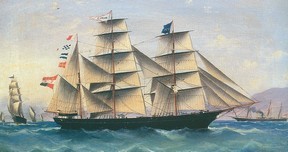
Croatian coat of arms in blue color on the barg Mimi P(ajkuric), built in Rijeka in 1866 (photo from Barbalic, Marendic, p. 56)
____________________________________________________________________________________
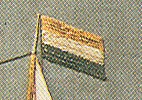
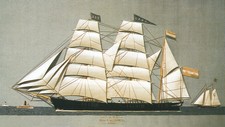
Croatian threecolor flag on barg Lada, built in Rijeka in 1871 (photo of the silk work from Barbalic, Marendic, p. 62)
____________________________________________________________________________________

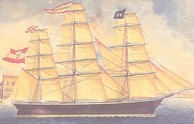
Croatian coat of arms on nave Marietta W(allner) (born Bakarcic), built in Rijeka in 1863 (photo from [Barbalic, Marendic, p. 73])
____________________________________________________________________________________
Two Croatian coats of arms on the Kostrena steamer (photo from [Barbalic, Marendic, p. 77]):
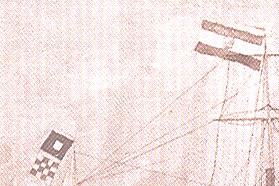
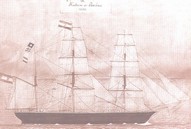
Pepe Medanovic, captain of a steamer "Kostrena", saved a French steamer Gaulois in Biskay bay in very difficult conditions. The French president conferred a medal. Maritime press reported on this saving throughout the world.
____________________________________________________________________________________
See the facsimile from Barbalic, Marendic, p. 77:
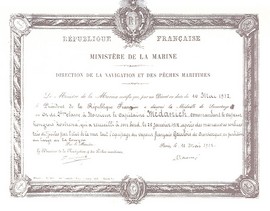
RÉPUBLIQUE FRANÇAISE
MINISTČRE DE LA MARINE
DIRECTION DE LA NAVIGAITON ET DES PĘCHES MARITIMES
Le Ministre de la Marine certifie que, par Décret en date du 10 mai 1912, le Président de la République Française a décerné la Médaille de Sauvetage en or de 2ęme classe ŕ Monsieur le capitaine Medanovich commandant le vapeur hongrois (!) "Kostrena", qui a recueilli ŕ son bord, le 25 janvier 1912, aprés de maneuvres rendues trés difficiles par l'état de la mer, tout l'equipage du vapeur français "Gaulois" de Bunhergue (?), en perdition au [?large ac tl Corogne?]
Par Directeur de la Navitation et les Pęches Maritimes
[signature]
Paris, le 10 Mai 1912
[signature]
____________________________________________________________________________________

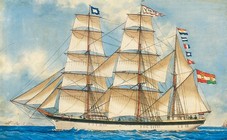
Barg Vinka with Croatian threecolor and a sketch of Croatian coat of arms, built in Sunderland in Great Britain in 1865, since 1879 in Croatia, in Kostrena. (photo from Barbalic, Marendic, p. 78)
____________________________________________________________________________________

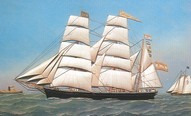
Barg Hrvat (The Croat), built in 1875 in Bakar (photo of the silk work from Barbalic, Marendic, p. 105)
____________________________________________________________________________________

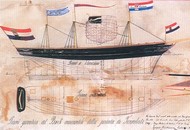
Plan of the barg Grad Karlovac (The City of Karlovac, in Croatia), built in Kraljevica in 1868 (photo from Barbalic, Marendic, p. 117)
____________________________________________________________________________________

Unknown boat with Croatian coat of arms in the middle of the mast (photo from Barbalic, Marendic, p. 123)
____________________________________________________________________________________

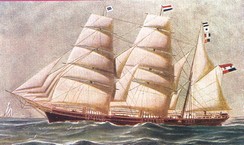
Barg Tri sina (Three Sons - of Vjenceslav Turkovic, a Croatian patriot and Maecenas), with Croatian threecolor flag (photo from Barbalic, Marendic, p. 124)
____________________________________________________________________________________
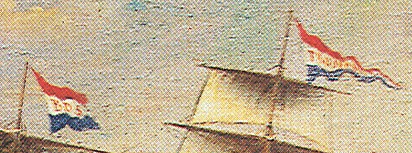
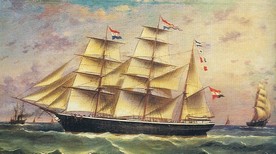
Barg Trojednica (Threeune, i.e. United Kingdom of Croatia, Dalmatia and Slavonia) , BDS (Brodarsko drutvo Senj - Shipping Society Senj). On the main mast there is the Croatian threecolor flag with the name of the barg - Trojednica. Painted by Ivancovich (photo from Barbalic, Marendic, p. 126). ____________________________________________________________________________________
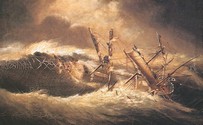
Barg Hervatska (Croatia), built in Senj in 1874. (photo from [Barbalic, Marendic, p. 132])
A Croatian bark named HERVATSKA, that is, CROATIA, sailing on February 2, 1882 from Philadelphia to Dalmatian ports, saved a crew of the English vessel, the CHEROKEE OF GREENOCK, during a desastrous storm in the Atlantic. It obtained a recognition of the English Queen. The bark was a property of the Senj Navigation Corporation. Senj is an important Croatian port in the Adriatic Sea. This information has been provided by The American Croatian HISTORICAL REVIEW in July 1946.
____________________________________________________________________________________
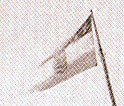
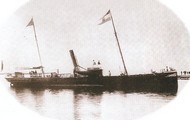
Steamer Hrvat (Croat) built in Recice near Rijeka in 1872, with Croatian flag on the main mast (photo from Barbalic, Marendic, p. 143)
____________________________________________________________________________________

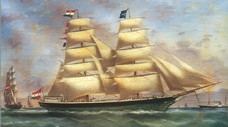
Brigantin Ida P(ersic), built in Rijeka in 1869 (the name was initally Secunda), (photo from Barbalic, Marendic, p. 164)
____________________________________________________________________________________
Benedikt Kotruljevic (Benedictus de Cotrullis from Dubrovnik) is the author of "De Navigatione", 1464. It is the first known manual on navigation in the history of Europe. Note that it appeared almost 30 years before the discovery of America.

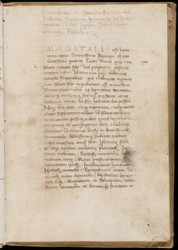
The original manuscript is kept at the University of Yale, USA, in the Beinecke Rare Book and Manuscript Library.
____________________________________________________________________________________
The church of St Nikola in Stari Grad on the island of Hvar is a votive church for fishermen and mariners. It keeps various paintings ordered by mariners which survived whipwrecks. The church was a seat of confreternaty of fisherman and mariners in Stari Grad. The town of Stari Grad has been founded by Greek settlers in 384 B.C., as witnessed by a stone monument with inscription carved in Greek language.
____________________________________________________________________________________
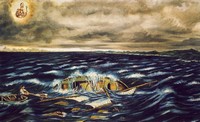 Koter "Marija" pod zapovjedniątvom Luke Kovacevica i mornara mu sina Mate kao i mornara Mije Kovacevica Nikole nastradao krcat pijeska uslijed jakog vjetra izmedju Braca i Staroga grada 11. Aprila 1907. (Pijesak je bio namijenjen za izgradnju Osnovne skole u Starom Gradu, D.Z.)
Koter "Marija" pod zapovjedniątvom Luke Kovacevica i mornara mu sina Mate kao i mornara Mije Kovacevica Nikole nastradao krcat pijeska uslijed jakog vjetra izmedju Braca i Staroga grada 11. Aprila 1907. (Pijesak je bio namijenjen za izgradnju Osnovne skole u Starom Gradu, D.Z.)
____________________________________________________________________________________
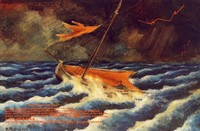 Bracera "Ime Isusovo" pod zapovjedniątvom Antuna Dragicevica pok. Jurja, dneva 14. septembra 1914. u Brackom kanalu zahvatila nas je strasna oluja od 9-11 sati jutrom. Od silna vjetra grego-levante, mora, kise i grada nismo vidili kraja. Zahvaljujuci Bogu i sv. Nikoli stigli smo sretno u luku Vela Vira. Na uspomenu: Antun Dragicevic pok. Jurja za sebe i druga. ____________________________________________________________________________________
Bracera "Ime Isusovo" pod zapovjedniątvom Antuna Dragicevica pok. Jurja, dneva 14. septembra 1914. u Brackom kanalu zahvatila nas je strasna oluja od 9-11 sati jutrom. Od silna vjetra grego-levante, mora, kise i grada nismo vidili kraja. Zahvaljujuci Bogu i sv. Nikoli stigli smo sretno u luku Vela Vira. Na uspomenu: Antun Dragicevic pok. Jurja za sebe i druga. ____________________________________________________________________________________
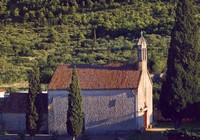 The church of St. Nikola in Stari Grad, Hvar (14/15th centuries). Photographs by Pawel Jarszewski, from a 2008 Calendar issued by Damir Cavic, Stari Grad. Many thanks to Matislav i Marija Kovacevic, Stari Grad, for the calendar.
The church of St. Nikola in Stari Grad, Hvar (14/15th centuries). Photographs by Pawel Jarszewski, from a 2008 Calendar issued by Damir Cavic, Stari Grad. Many thanks to Matislav i Marija Kovacevic, Stari Grad, for the calendar.
____________________________________________________________________________________
Nikola Primorac Croatian captain of City of Ragusa craft sailing from Liverpool to New York and back in 1870 ____________________________________________________________________________________
The Savannah nuclear ship, the first nuclear-powered merchant ship, was built to the plans of Erazmo Tićac 1904-1968, born in Croatia in Žurkovo near the city of Rijeka. After the president Dwight Eisenhower announced his decision to build a nuclear-powered merchant ship in 1955, the planning was entrusted to the firm The Sharp Brothers Inc., and Tićac became the leading planner. On a plaque above the entrance to the ship's lounge was written in golden letters: "Ben Tićac, naval architect". ____________________________________________________________________________________
[Old Croatian Letters] ____________________________________________________________________________________
CROATIANS SAILED TO NEW WORLD BEFORE COLUMBUS AND VIKINGS?===
 Moorish Croats: During the medieval Cordoba Emirate and Caliphate under Omeyids dinasty, a number of Croats from Dalmatia reached Moorish Spain, either enslaved by Arabian pirates or also as mercenaries and workers; they present the earliest known Croatian diaspora, and also the first confirmed Croats converted to Islam. The most reputed among them are the Moorish army generals of Dalmatian origin: Hadjib Badr in 10th century, and Wadha el-Ameri, Zohair al-Ameri, Mudjahid Al-Ameri and Ali Al-Ameri in 11th century. Hadjib Badr (original surname: Badrov) was born in Dalmatia in the second half of 9th century. Then he came in the Cordoba Emirate of Moorish Spain under the Omayads dinasty, and as a mercenary he converted to islam there. He advanced in Moorish army up to his supreme position of the main military leader of islamic Spain between 902 - 921. Due to his activities, this land expanded over Spain and Maghreb, and became the independent Cordoba Calyphate under Abdurrahman III. Badrov was among the first known Croats reaching an important position out of his homeland, and first attested Croat converted to islam. Generals al-Ameri: In the medieval history of 10th and 11th century the most reputed are two Dalmatians immigrated in Moorish Spain under the Omayads dynasty. Both were mercenaries, and then became there the main military leaders of Cordoba Caliphate: Wadha el-Ameri (1009-1013) and his son Zohair al-Ameri (1018-1036), and also Mudjahid al-Ameri (1011-1045) and his son Ali al-Ameri (1045-1076) as the leaders of taifa Denia-Baleares. A hypothesis indicates that America was named after them, because they organized the Moorish expeditions in Western ocean; the same suggest also Al-Idrizi's medieval indications on Atlantic, the old Arabic inscriptions in American cliffs, and new findings of coins with kuffic inscriptions in USA. From them probably descend the medieval ethnic group of Hvirtamanna in eastern USA, which was mentioned in the old Viking reports; their descendants may be the recent tribe Croatans in southeastern coast of USA, being the best known indicator on the early presence of Croats in America. Croat petroglyphs (medieval inscriptions by overseas Croats): Before 3 decades in Bahia coast of Brasil a medieval inscription on stone was found, reminding of the medieval Glagolitic alphabet in the early Croatia. Subsequently also 61 similar inscriptions of this Glagolitic type from 7th - 14th centuries on the rocks of Mt Sierra de Amambay in Paraguay have been discovered. Some American scientists think that the scriptors of these petroglyphs probably took part in the construction of the earliest American town Tiwanaku (Tiahuanaco). Andrija Zeljko Lovric presented his paper of archeological finds of Islamic coins and Glagolitic writing in Paraguay on the second day of the symposium called The Islamic World in the Twentieth Century, held in the Zagreb Islamic Center. He speaks that previous explorers did not understand the script and believed it to be Viking runes. Lovric lists numerous data contributing to the theory that the traces lead to Croatian sailors. First of all, among all Slav peoples that used the Glagolitic alphabet, only the Croats were renowned as sailors and, technically speaking, the only ones who could have reached America. In addition, the Glagolitic script was used the longest by Croats. Second, in town of Tiwanaku (Tiahuanaco), the statues of Guarani rulers bearing Croatian coats of arms on their chests were found. Even more exciting for inquiring Americans are the fabulous discoveries of Dragutin Pavlicevic, Senior Research Fellow at the University of Zagreb’s Institute for Croatian History. Known far and wide as the best historian in his weight class, Pavlicevic’s robust, enhanced and exceptional methodology has uncovered the Croat origins of a number of American Indian tribes, including the Croatans, a North Carolina tribe originating in the noble blood of Croat mariners, a Croat fact confirmed by local place-names (e.g., Croatan Sound; Croatamung Island) as well as skin color, hair and facial features (e.g., the gray eyes and light hair found in Croatia in greater number than in any other Mediterranean people). Another Croat-Indian tribe, the Mateos, carry the name of their Croat progenitor, Mate. Never one to exaggerate facts or inflate numbers, Pavlicevic estimates there are some two million Croato-Indians in the United States alone. A hallowed name in Croat studies, Adam S. Eterovic’s extraordinary research also offers compelling evidence of an early Croat presence in the New World, especially in terms of breathtaking linguistic and onomastic evidence stretching from Brazil to New York.
Moorish Croats: During the medieval Cordoba Emirate and Caliphate under Omeyids dinasty, a number of Croats from Dalmatia reached Moorish Spain, either enslaved by Arabian pirates or also as mercenaries and workers; they present the earliest known Croatian diaspora, and also the first confirmed Croats converted to Islam. The most reputed among them are the Moorish army generals of Dalmatian origin: Hadjib Badr in 10th century, and Wadha el-Ameri, Zohair al-Ameri, Mudjahid Al-Ameri and Ali Al-Ameri in 11th century. Hadjib Badr (original surname: Badrov) was born in Dalmatia in the second half of 9th century. Then he came in the Cordoba Emirate of Moorish Spain under the Omayads dinasty, and as a mercenary he converted to islam there. He advanced in Moorish army up to his supreme position of the main military leader of islamic Spain between 902 - 921. Due to his activities, this land expanded over Spain and Maghreb, and became the independent Cordoba Calyphate under Abdurrahman III. Badrov was among the first known Croats reaching an important position out of his homeland, and first attested Croat converted to islam. Generals al-Ameri: In the medieval history of 10th and 11th century the most reputed are two Dalmatians immigrated in Moorish Spain under the Omayads dynasty. Both were mercenaries, and then became there the main military leaders of Cordoba Caliphate: Wadha el-Ameri (1009-1013) and his son Zohair al-Ameri (1018-1036), and also Mudjahid al-Ameri (1011-1045) and his son Ali al-Ameri (1045-1076) as the leaders of taifa Denia-Baleares. A hypothesis indicates that America was named after them, because they organized the Moorish expeditions in Western ocean; the same suggest also Al-Idrizi's medieval indications on Atlantic, the old Arabic inscriptions in American cliffs, and new findings of coins with kuffic inscriptions in USA. From them probably descend the medieval ethnic group of Hvirtamanna in eastern USA, which was mentioned in the old Viking reports; their descendants may be the recent tribe Croatans in southeastern coast of USA, being the best known indicator on the early presence of Croats in America. Croat petroglyphs (medieval inscriptions by overseas Croats): Before 3 decades in Bahia coast of Brasil a medieval inscription on stone was found, reminding of the medieval Glagolitic alphabet in the early Croatia. Subsequently also 61 similar inscriptions of this Glagolitic type from 7th - 14th centuries on the rocks of Mt Sierra de Amambay in Paraguay have been discovered. Some American scientists think that the scriptors of these petroglyphs probably took part in the construction of the earliest American town Tiwanaku (Tiahuanaco). Andrija Zeljko Lovric presented his paper of archeological finds of Islamic coins and Glagolitic writing in Paraguay on the second day of the symposium called The Islamic World in the Twentieth Century, held in the Zagreb Islamic Center. He speaks that previous explorers did not understand the script and believed it to be Viking runes. Lovric lists numerous data contributing to the theory that the traces lead to Croatian sailors. First of all, among all Slav peoples that used the Glagolitic alphabet, only the Croats were renowned as sailors and, technically speaking, the only ones who could have reached America. In addition, the Glagolitic script was used the longest by Croats. Second, in town of Tiwanaku (Tiahuanaco), the statues of Guarani rulers bearing Croatian coats of arms on their chests were found. Even more exciting for inquiring Americans are the fabulous discoveries of Dragutin Pavlicevic, Senior Research Fellow at the University of Zagreb’s Institute for Croatian History. Known far and wide as the best historian in his weight class, Pavlicevic’s robust, enhanced and exceptional methodology has uncovered the Croat origins of a number of American Indian tribes, including the Croatans, a North Carolina tribe originating in the noble blood of Croat mariners, a Croat fact confirmed by local place-names (e.g., Croatan Sound; Croatamung Island) as well as skin color, hair and facial features (e.g., the gray eyes and light hair found in Croatia in greater number than in any other Mediterranean people). Another Croat-Indian tribe, the Mateos, carry the name of their Croat progenitor, Mate. Never one to exaggerate facts or inflate numbers, Pavlicevic estimates there are some two million Croato-Indians in the United States alone. A hallowed name in Croat studies, Adam S. Eterovic’s extraordinary research also offers compelling evidence of an early Croat presence in the New World, especially in terms of breathtaking linguistic and onomastic evidence stretching from Brazil to New York.
 Back to the portal Index:
Back to the portal Index:
article by author Mr. Darko Zubrinic, Zagreb (1995), Source: from website Croatian history.net - Croatian mariners in the New World; Croatian Guilds and Collegiums
The oldest known Croatian Guild of merchants in Italy was founded in 1375 in the city of Recanti - Faternitas Sclauourm Sancti Petri Martiris. According to Venetian archives, nearly 20% of the eastern part of the city of Venice called Castello was Croatian. Even today there are streets, squares, passages, bridges and churches in Venice that bear witness of the presence of Croats during many centuries, most often in the name of Schiavone, Brazza (= the island of Brac), Lesina (= the island of Hvar) etc. For more details see an article by Lovorka Coralic in Croazia/Italia.
____________________________________________________________________________________
Croatian coat of arms (on threecolor flag), on the left mast of the Enrica brig, built in Rijeka in 1868


The Croatian Guild of St Juraj and Tripun founded in 1451 (Scuola dei SS Giorgi et Trifon, also called Scuola degli Sciavoni, Scula Dalmata, Scula nazione Illirica) had its site in the Church of St Giorgio and Trifon. It possesses valuable paintings of V. Carpaccio. The Guild is active even today. Many Croats from Boka Kotorska (annexed to Montenegro in 1945) were also its members.
In the church of S. Pietro di Castello on the islet Olivolo in Venice, there are interesting traces of close ties with Croats:
The Guild of St. Jerome in Udine was founded in 1452.

Very important Croatian Congregation of St. Jerome in Rome was founded in the beginning of the 15th century, and already in 1453 had its church in Rome, with the associated hospital and guest-house for pilgrims, refugees and exiles from the Croatian ethnic areas occupied by the Turks. It is interesting that besides the Latin Mass also Glagolitic Liturgy had been served regularly in the Church of St Jerome, with the use of Glagolitic missals and breviaries. The congregation exists even today, under the name of Croatian Papal Collegium of St. Jerome. The name was given by a rescript of Pope Paul VI in 1971.
Also very important in educating our students was a Croatian Collegium in Bologna (1553-1781), founded first as Collegium Hungarica - Illyricum, then soon Croatized, as Hungarians had their own Collegium Hungaricum in Rome since 1578.
Collegium Illyricum in Loreto was founded in 1580, intended to educate Croatian youth, with 30-36 students. It was acting with interruptions until 1860. During three centuries about 1,000 Croatian students were educated there. The most outstanding of them was Bartol Kasic (1571-1650), author of the first Croatian grammar (Rome, 1604).
The earliest known description of a sporting event in Croatia is from the 16th century. It reffered to the 1593 regatta of seventy four (yes, 74) wooden fishing boats called falkusa (Croatian: falkuša), from the harbour of the town of Komiza on the island of Vis to the islet of Palagruza. It was the oldest known boat race in Europe. Falkusa is autochthonous Croatian boat of 9m of length, with the mast of equal size, in use from 11th or 12th century until the middle of the 20th century. A crew was composed of five rowers, and the marathon covered 42 miles, for which about five to fifteen hours of continuous and exhausting rowing was necessary, depending on weather conditions.
 Falkuša / Falkusa, autochthonous Croatian boat from the town of Komiza, island of Vis
Falkuša / Falkusa, autochthonous Croatian boat from the town of Komiza, island of Vis
The very start of the marathon of the armada was announced by a cannon from the Renaissance tower in the Komiza harbour early in the morning of 20th May. One can imagine the foam raised by 74 boats and 370 rows in the harbour! The description of this interesting event is kept in the Liber Comissiae in the parish of the town of Vis on the island of Vis. In 1998 falkusa was included into the UNESCO World Heritage List. See Prvi zapis o Palagurskoj regati (in Croatian), Gajeta Falkusa, Vis (in Polish), The Falkusa.
____________________________________________________________________________________
 A Croatian falkusa sailed from Komiza to Lisabon to be exhibited at EXPO'98, where Croatia was the greatest surprise. Postage stamp designed by Danijel Popovic, Zagreb.
A Croatian falkusa sailed from Komiza to Lisabon to be exhibited at EXPO'98, where Croatia was the greatest surprise. Postage stamp designed by Danijel Popovic, Zagreb.
The next earliest known description of a sporting event in Croatia is from the 18th century (1764). It referred to the regatta of two fishing boats representing the cities of Split and Makarska, from an islet near Milna on the island of Brac to the Split harbour. It was the Makaran boat that triumphed!
One of truly fascinating exploits in which Croatian mariners participated is related to ARCTIC EXPEDITION in 1872-1874, organized by the then Austrian-Hungarian Empire. The Croats at that time had the status of Kingdom within the Empire.
The name of Ragusa (=Dubrovnik) and St Vlaho, patron of Ragusa, and also other Croatian names appear on old maps of Central America already in the 16th, soon after discoveries of Cristophor Columbus, John and Sebastian Cabot. Capo de Arause appears on John Cabot's map (15th century) between New York and Cape Cod. Arase was a corrupted Spanish, Portuguese and Italian pronunciation of Ragusa (Dubrovnik).
Some of Sebastian Cabot's mariners were Bozo de Araguz (from Ragusa), Stephen de Lezna (= Lesina = Hvar, Croatian island), Stephen de Arva (= Arbe = island of Rab). According to Adam S. Eterovich about 20 percent of S. Cabot's crew was Croatian.
Croatian mariners organized a chapel of Saint Vlaho in the Church of Santa Maria di Castello in Genoa in the 1400's. The name of Ragusa has many variations: Aragoso, Arause, Araguz, Rhagusi, Ragoza, Rausa etc. Also the name of St Vlaho, patron of Ragusa (Dubrovnik): Bigio, Blaas, Blas, Blaise, Blaze, Braz, Bras.
In the area of Panama there is an Otoque island (otok = island in Croatian!), close to the Pacific side of the Panama canal. In the same area there is Saboga island (sa Boga = za Boga = for God). More to the south there is Punta Mala (mala = small in Croatian, i.e. a small point). In the Panam area the name of San Blas (= St Vlaho, patron of Ragusa) is mentioned several times: San Blas Point, San Blas Bay, San Blas Mountains.
Sebastian Cabot also traveled to Brazil, Uruguay, Argentina and Paraguay. His map of the voyage to the Rio De La Plata in 1526-30 has a bay Mime Ragoso - or "just like Ragusa", which is in Brazil! It is interesting that ship's officer on this voyage was Matias Mafrolo, who was Slavonian, i.e. the Croat.
An important discovery of Adam S. Eterovich regarding the Croats in the New World covers several obviously Ragusan names of mariners in the famous Columbus crew in 1492: Martin de Araguis, Pedro de Arague. For more details see Eterovic, p. 32-38.
It is a fact that Giovanni Verrazano gave also Dalmatian and Croatian names to various toponyms in the New World during his voyages along the Atlantic coast of New England, New York, the Carolinas, Florida in 1523-1524 (Malabrigo, S. Blas, Mala gente, Costa do Brada, Golfo di Castelli, Fiume, Brioni etc.). In a book by Jacques Habert on the Voyages of Verrazano a chapter heading is entitled "La Dalmatie de Nouveau Monde", 1964 (Dalmatia of the New World), in a book by Carlos Pazzini we have "La Dalmazia Del Nuouvo Mondo", The American Scenic and Historical Society in a description of the American coast has a heading "Dalmatia of the New World", 1910. According to Adam Eterovich, the fact that Verrazano has no geneaology in Italy or France seems to suggest to seek his roots in Dalmatia, not in Italy: Giovanni -Ivan, Verrazano - Veratius, Vrantzius, Vranyczany, Vranjanin, Vrancic. The nobility of Europe always maintained very detailed and accurate geneaologies for rights of title, succession and property. E.G. Tudor in his Tudor Geography (1934, London) states: "A majority of the mariners and the pilots on the king's ships at this period were foreigners - Ragusans (listed first), Venetians (mostly our "Sclavonians", since Dalmatia at that time belonged to Venice, and represented about 70% of its entire territory), Genovese, Normans and Bretons". This was noted by the French Ambassador Marillac in 1540. See Adam S. Eterovich's "The Verrazano voyages to America and Canada 1523-1524", Croatia in the New World, Ragusan Press, San Carlos, USA, 1990.
There are very strong and convincing indications that even Marco Polo, Marco Polo was a descendant of the Croats (Marko Pilich).
Many of the early European expeditions to the western shore of the Atlantic finished with shipwrecks. So was the case with some ships from Dubrovnik in the 16th century. It is interesting to mention that the Croatan Indians in the USA could possibly be the descendants of the saved Croatian crew, as authenticated by their name, brown hair, blue eyes and some of the words in their language. Two large islands appear on the Molineaux map of Virginia, USA (1599), with the names Croatoan and Croatamonge (see Eterovic, p. 30).

An American writer John Lawson in his 1714 chronicle wrote that among Croatan Indians of that time there was a legend of a 16th century shipwreck with mariners who saved themselves and stayed with Indians.
See also: Croatoan Indians: Trace of the legend of Croatians in North Carolina, USA (on the Geni).
In attempts to find Walter Raleigh's Lost Colony inhabited by the British Empire in 1587 on the island of Roanoke (near the Croatoan island, North Carolina, USA), the searchers found a CRO carved in Roman letters on a tree in 1590. Another big tree had a bark peeled off, and carved on it in capital letters was the word CROATOAN. For more information see CROATOAN – The "Lost Colony" of Roanoke, written by Ivan Marjanovic De Tonya (Croatian American poet and author).
It is indicative that a (French?) lexicographer and maritime historian J. Jal included in his Glossair nautique about 500 original Croatian maritime terms.
 Steamship Hrvatska (Croatia), 1904 (from R.F. Barbalic, I. Marendic: Onput, kad smo partili, MH Rijeka, 2004, with permission of Mr. Darko Dekovic)
Steamship Hrvatska (Croatia), 1904 (from R.F. Barbalic, I. Marendic: Onput, kad smo partili, MH Rijeka, 2004, with permission of Mr. Darko Dekovic)
One of truly fascinating exploits in which Croatian mariners participated is related to ARCTIC EXPEDITION in 1872-1874, organized by the Austrian-Hungarian state. See also: Croatian mariners in the famous Arctic Expedition (1872-1874.): The discovery of Franz Josef Land
Captain Mate Dulcic Hraste-Pucetov from the island of Hvar obtained a silver jug from the British Governement as a recognition for saving the boat "St. Croix". Gilted inside, 14.5 cm high and with diameter of the opening of 8.5 cm, the jug bears the the following inscription see [Mate Milicic et al., p 68]:
Presented by the British Government to captain Matteo Dulcich Hraste of the "Giovanni D" of Jelsa in acknowledgement of his humanity and kindness to the shipwrecked crew of the "St. Croix" of Jersey, 27 September 1877, abandoned at sea.
Captain Marko Vekarich, Master of the Austro-Hungarian Barque "Isaac", received the following letter from the Government of Canada for saving the shipwrecked crew of Canadian ship "Angle" in the Atlantic (the letter is kept in the town of Orebic, Peljesac peninsula near Dubrovnik):
OFFICIAL SEAL MARINE OF FISCHERIES
Ottawa, 12th February 1879
Sir
Her Majesty's Government having brought under the notice of this Department the circumstances connected with the wrecke of the "Angle" of St. John, New Bruswick, and the services rendered by you, as Master of the "Isaac", to the shipwrecked crew, it affords me much satisfaction to convey to you the thanks of the Government of Canada and to request your acceptance of the accompaning gold watch, which has been awarded in recognition of you human and generous services.
I am, Sir, your most obediant servant James C. Voke Minister of Marine etc.
In 1861 captain Jozo Šunj (Sunj) from Orebic (Peljesac peninsula), Master of the Barque "Nicolo Despot", obtained official recognition and gold chronometer with engraved dedication from Abraham Lincoln, president of the USA, for having saved the crew of the USA sailor "Homer" in the Atlantic.
Society for building and exploitation of long range navigation vessels (later Maritime Society of Peljesac) in Orebic was founded in 1865. In 1873 the Society had 90 great and nice vessels with total weight of 45000 tons, with 2000 employed, out of which 250 were captains. The Society existed until 1891.
____________________________________________________________________________________
The Hrvat (Croat) steamship, the first Croatian steamship, was built in the Rijeka Technical Factory (Stabilimento tecnico fiumano) to plans by the Rijeka engineer Otto Schlick and launched on 13th July 1872 as the first ship of its kind built on the Croatian coast for a domestic customer. It was ordered by the Shipping society from Senj that intended to establish a line of passenger and cargo ships between Rijeka and Senj. The ship was made of iron, was 34.65 m long and 4.80 m wide, and powered by a 130-horsepower steam engine. It had a capacity of 82 gross register tons and a crew of nine. Regular passage between the two harbours was established on the 7th September of the same year. Initially it sailed five times a week in summer and three times a week in winter, with stops in Novi Vinodolski, Selce, Crikvenica, Voz, Kraljevica and Bakar. The ship sailed under the flag of the Ungaro-Croata shipping company. It was sold in 1903 in Mali Lošinj where it was renowned, and resold to Izola under the name of Besenghi. It disappeared from the list of ships in 1916. Source of the text www.kvarner.hr Kvarner's Cultural History, Cultural Heritage on Kvarner - INDUSTRIAL AND TECHNICAL HERITAGE (www.kvarner.hr).
____________________________________________________________________________________
The brig is a two-masted sailing ship where both masts are square rigged. The rear mast carries a gaff sail as well, see definitions of various shiptypes here.
I express my sincere gratitude to Mr Darko Dekovic, Rijeka, for permission to use photos from a wonderful monograph Barbalic, Marendic.

 Croatian coat of arms (on threecolor flag) on the front mast of the Enrica brig built in 1868 in Rijeka, 40 m long. Captian Paskval Stipanovic, travelled to New York, Belfast, Queenstown, Cardiff, Montreal, Gibraltar
Croatian coat of arms (on threecolor flag) on the front mast of the Enrica brig built in 1868 in Rijeka, 40 m long. Captian Paskval Stipanovic, travelled to New York, Belfast, Queenstown, Cardiff, Montreal, Gibraltar
Painted by a French painter Antoine Roux, junior, 1892 (photo from [Barbalic, Marendic, p. 16] ) ____________________________________________________________________________________


Croatian coat of arms in blue color on the barg Mimi P(ajkuric), built in Rijeka in 1866 (photo from Barbalic, Marendic, p. 56)
____________________________________________________________________________________


Croatian threecolor flag on barg Lada, built in Rijeka in 1871 (photo of the silk work from Barbalic, Marendic, p. 62)
____________________________________________________________________________________


Croatian coat of arms on nave Marietta W(allner) (born Bakarcic), built in Rijeka in 1863 (photo from [Barbalic, Marendic, p. 73])
____________________________________________________________________________________
Two Croatian coats of arms on the Kostrena steamer (photo from [Barbalic, Marendic, p. 77]):


Pepe Medanovic, captain of a steamer "Kostrena", saved a French steamer Gaulois in Biskay bay in very difficult conditions. The French president conferred a medal. Maritime press reported on this saving throughout the world.
____________________________________________________________________________________
See the facsimile from Barbalic, Marendic, p. 77:

RÉPUBLIQUE FRANÇAISE
MINISTČRE DE LA MARINE
DIRECTION DE LA NAVIGAITON ET DES PĘCHES MARITIMES
Le Ministre de la Marine certifie que, par Décret en date du 10 mai 1912, le Président de la République Française a décerné la Médaille de Sauvetage en or de 2ęme classe ŕ Monsieur le capitaine Medanovich commandant le vapeur hongrois (!) "Kostrena", qui a recueilli ŕ son bord, le 25 janvier 1912, aprés de maneuvres rendues trés difficiles par l'état de la mer, tout l'equipage du vapeur français "Gaulois" de Bunhergue (?), en perdition au [?large ac tl Corogne?]
Par Directeur de la Navitation et les Pęches Maritimes
[signature]
Paris, le 10 Mai 1912
[signature]
____________________________________________________________________________________


Barg Vinka with Croatian threecolor and a sketch of Croatian coat of arms, built in Sunderland in Great Britain in 1865, since 1879 in Croatia, in Kostrena. (photo from Barbalic, Marendic, p. 78)
____________________________________________________________________________________


Barg Hrvat (The Croat), built in 1875 in Bakar (photo of the silk work from Barbalic, Marendic, p. 105)
____________________________________________________________________________________


Plan of the barg Grad Karlovac (The City of Karlovac, in Croatia), built in Kraljevica in 1868 (photo from Barbalic, Marendic, p. 117)
____________________________________________________________________________________

Unknown boat with Croatian coat of arms in the middle of the mast (photo from Barbalic, Marendic, p. 123)
____________________________________________________________________________________


Barg Tri sina (Three Sons - of Vjenceslav Turkovic, a Croatian patriot and Maecenas), with Croatian threecolor flag (photo from Barbalic, Marendic, p. 124)
____________________________________________________________________________________


Barg Trojednica (Threeune, i.e. United Kingdom of Croatia, Dalmatia and Slavonia) , BDS (Brodarsko drutvo Senj - Shipping Society Senj). On the main mast there is the Croatian threecolor flag with the name of the barg - Trojednica. Painted by Ivancovich (photo from Barbalic, Marendic, p. 126). ____________________________________________________________________________________

Barg Hervatska (Croatia), built in Senj in 1874. (photo from [Barbalic, Marendic, p. 132])
A Croatian bark named HERVATSKA, that is, CROATIA, sailing on February 2, 1882 from Philadelphia to Dalmatian ports, saved a crew of the English vessel, the CHEROKEE OF GREENOCK, during a desastrous storm in the Atlantic. It obtained a recognition of the English Queen. The bark was a property of the Senj Navigation Corporation. Senj is an important Croatian port in the Adriatic Sea. This information has been provided by The American Croatian HISTORICAL REVIEW in July 1946.
____________________________________________________________________________________


Steamer Hrvat (Croat) built in Recice near Rijeka in 1872, with Croatian flag on the main mast (photo from Barbalic, Marendic, p. 143)
____________________________________________________________________________________


Brigantin Ida P(ersic), built in Rijeka in 1869 (the name was initally Secunda), (photo from Barbalic, Marendic, p. 164)
____________________________________________________________________________________
Benedikt Kotruljevic (Benedictus de Cotrullis from Dubrovnik) is the author of "De Navigatione", 1464. It is the first known manual on navigation in the history of Europe. Note that it appeared almost 30 years before the discovery of America.


The original manuscript is kept at the University of Yale, USA, in the Beinecke Rare Book and Manuscript Library.
____________________________________________________________________________________
The church of St Nikola in Stari Grad on the island of Hvar is a votive church for fishermen and mariners. It keeps various paintings ordered by mariners which survived whipwrecks. The church was a seat of confreternaty of fisherman and mariners in Stari Grad. The town of Stari Grad has been founded by Greek settlers in 384 B.C., as witnessed by a stone monument with inscription carved in Greek language.
____________________________________________________________________________________
 Koter "Marija" pod zapovjedniątvom Luke Kovacevica i mornara mu sina Mate kao i mornara Mije Kovacevica Nikole nastradao krcat pijeska uslijed jakog vjetra izmedju Braca i Staroga grada 11. Aprila 1907. (Pijesak je bio namijenjen za izgradnju Osnovne skole u Starom Gradu, D.Z.)
Koter "Marija" pod zapovjedniątvom Luke Kovacevica i mornara mu sina Mate kao i mornara Mije Kovacevica Nikole nastradao krcat pijeska uslijed jakog vjetra izmedju Braca i Staroga grada 11. Aprila 1907. (Pijesak je bio namijenjen za izgradnju Osnovne skole u Starom Gradu, D.Z.)
____________________________________________________________________________________
 Bracera "Ime Isusovo" pod zapovjedniątvom Antuna Dragicevica pok. Jurja, dneva 14. septembra 1914. u Brackom kanalu zahvatila nas je strasna oluja od 9-11 sati jutrom. Od silna vjetra grego-levante, mora, kise i grada nismo vidili kraja. Zahvaljujuci Bogu i sv. Nikoli stigli smo sretno u luku Vela Vira. Na uspomenu: Antun Dragicevic pok. Jurja za sebe i druga. ____________________________________________________________________________________
Bracera "Ime Isusovo" pod zapovjedniątvom Antuna Dragicevica pok. Jurja, dneva 14. septembra 1914. u Brackom kanalu zahvatila nas je strasna oluja od 9-11 sati jutrom. Od silna vjetra grego-levante, mora, kise i grada nismo vidili kraja. Zahvaljujuci Bogu i sv. Nikoli stigli smo sretno u luku Vela Vira. Na uspomenu: Antun Dragicevic pok. Jurja za sebe i druga. ____________________________________________________________________________________
 The church of St. Nikola in Stari Grad, Hvar (14/15th centuries). Photographs by Pawel Jarszewski, from a 2008 Calendar issued by Damir Cavic, Stari Grad. Many thanks to Matislav i Marija Kovacevic, Stari Grad, for the calendar.
The church of St. Nikola in Stari Grad, Hvar (14/15th centuries). Photographs by Pawel Jarszewski, from a 2008 Calendar issued by Damir Cavic, Stari Grad. Many thanks to Matislav i Marija Kovacevic, Stari Grad, for the calendar.
____________________________________________________________________________________
Nikola Primorac Croatian captain of City of Ragusa craft sailing from Liverpool to New York and back in 1870 ____________________________________________________________________________________
The Savannah nuclear ship, the first nuclear-powered merchant ship, was built to the plans of Erazmo Tićac 1904-1968, born in Croatia in Žurkovo near the city of Rijeka. After the president Dwight Eisenhower announced his decision to build a nuclear-powered merchant ship in 1955, the planning was entrusted to the firm The Sharp Brothers Inc., and Tićac became the leading planner. On a plaque above the entrance to the ship's lounge was written in golden letters: "Ben Tićac, naval architect". ____________________________________________________________________________________
[Old Croatian Letters] ____________________________________________________________________________________
CROATIANS SAILED TO NEW WORLD BEFORE COLUMBUS AND VIKINGS?===
 Moorish Croats: During the medieval Cordoba Emirate and Caliphate under Omeyids dinasty, a number of Croats from Dalmatia reached Moorish Spain, either enslaved by Arabian pirates or also as mercenaries and workers; they present the earliest known Croatian diaspora, and also the first confirmed Croats converted to Islam. The most reputed among them are the Moorish army generals of Dalmatian origin: Hadjib Badr in 10th century, and Wadha el-Ameri, Zohair al-Ameri, Mudjahid Al-Ameri and Ali Al-Ameri in 11th century. Hadjib Badr (original surname: Badrov) was born in Dalmatia in the second half of 9th century. Then he came in the Cordoba Emirate of Moorish Spain under the Omayads dinasty, and as a mercenary he converted to islam there. He advanced in Moorish army up to his supreme position of the main military leader of islamic Spain between 902 - 921. Due to his activities, this land expanded over Spain and Maghreb, and became the independent Cordoba Calyphate under Abdurrahman III. Badrov was among the first known Croats reaching an important position out of his homeland, and first attested Croat converted to islam. Generals al-Ameri: In the medieval history of 10th and 11th century the most reputed are two Dalmatians immigrated in Moorish Spain under the Omayads dynasty. Both were mercenaries, and then became there the main military leaders of Cordoba Caliphate: Wadha el-Ameri (1009-1013) and his son Zohair al-Ameri (1018-1036), and also Mudjahid al-Ameri (1011-1045) and his son Ali al-Ameri (1045-1076) as the leaders of taifa Denia-Baleares. A hypothesis indicates that America was named after them, because they organized the Moorish expeditions in Western ocean; the same suggest also Al-Idrizi's medieval indications on Atlantic, the old Arabic inscriptions in American cliffs, and new findings of coins with kuffic inscriptions in USA. From them probably descend the medieval ethnic group of Hvirtamanna in eastern USA, which was mentioned in the old Viking reports; their descendants may be the recent tribe Croatans in southeastern coast of USA, being the best known indicator on the early presence of Croats in America. Croat petroglyphs (medieval inscriptions by overseas Croats): Before 3 decades in Bahia coast of Brasil a medieval inscription on stone was found, reminding of the medieval Glagolitic alphabet in the early Croatia. Subsequently also 61 similar inscriptions of this Glagolitic type from 7th - 14th centuries on the rocks of Mt Sierra de Amambay in Paraguay have been discovered. Some American scientists think that the scriptors of these petroglyphs probably took part in the construction of the earliest American town Tiwanaku (Tiahuanaco). Andrija Zeljko Lovric presented his paper of archeological finds of Islamic coins and Glagolitic writing in Paraguay on the second day of the symposium called The Islamic World in the Twentieth Century, held in the Zagreb Islamic Center. He speaks that previous explorers did not understand the script and believed it to be Viking runes. Lovric lists numerous data contributing to the theory that the traces lead to Croatian sailors. First of all, among all Slav peoples that used the Glagolitic alphabet, only the Croats were renowned as sailors and, technically speaking, the only ones who could have reached America. In addition, the Glagolitic script was used the longest by Croats. Second, in town of Tiwanaku (Tiahuanaco), the statues of Guarani rulers bearing Croatian coats of arms on their chests were found. Even more exciting for inquiring Americans are the fabulous discoveries of Dragutin Pavlicevic, Senior Research Fellow at the University of Zagreb’s Institute for Croatian History. Known far and wide as the best historian in his weight class, Pavlicevic’s robust, enhanced and exceptional methodology has uncovered the Croat origins of a number of American Indian tribes, including the Croatans, a North Carolina tribe originating in the noble blood of Croat mariners, a Croat fact confirmed by local place-names (e.g., Croatan Sound; Croatamung Island) as well as skin color, hair and facial features (e.g., the gray eyes and light hair found in Croatia in greater number than in any other Mediterranean people). Another Croat-Indian tribe, the Mateos, carry the name of their Croat progenitor, Mate. Never one to exaggerate facts or inflate numbers, Pavlicevic estimates there are some two million Croato-Indians in the United States alone. A hallowed name in Croat studies, Adam S. Eterovic’s extraordinary research also offers compelling evidence of an early Croat presence in the New World, especially in terms of breathtaking linguistic and onomastic evidence stretching from Brazil to New York.
Moorish Croats: During the medieval Cordoba Emirate and Caliphate under Omeyids dinasty, a number of Croats from Dalmatia reached Moorish Spain, either enslaved by Arabian pirates or also as mercenaries and workers; they present the earliest known Croatian diaspora, and also the first confirmed Croats converted to Islam. The most reputed among them are the Moorish army generals of Dalmatian origin: Hadjib Badr in 10th century, and Wadha el-Ameri, Zohair al-Ameri, Mudjahid Al-Ameri and Ali Al-Ameri in 11th century. Hadjib Badr (original surname: Badrov) was born in Dalmatia in the second half of 9th century. Then he came in the Cordoba Emirate of Moorish Spain under the Omayads dinasty, and as a mercenary he converted to islam there. He advanced in Moorish army up to his supreme position of the main military leader of islamic Spain between 902 - 921. Due to his activities, this land expanded over Spain and Maghreb, and became the independent Cordoba Calyphate under Abdurrahman III. Badrov was among the first known Croats reaching an important position out of his homeland, and first attested Croat converted to islam. Generals al-Ameri: In the medieval history of 10th and 11th century the most reputed are two Dalmatians immigrated in Moorish Spain under the Omayads dynasty. Both were mercenaries, and then became there the main military leaders of Cordoba Caliphate: Wadha el-Ameri (1009-1013) and his son Zohair al-Ameri (1018-1036), and also Mudjahid al-Ameri (1011-1045) and his son Ali al-Ameri (1045-1076) as the leaders of taifa Denia-Baleares. A hypothesis indicates that America was named after them, because they organized the Moorish expeditions in Western ocean; the same suggest also Al-Idrizi's medieval indications on Atlantic, the old Arabic inscriptions in American cliffs, and new findings of coins with kuffic inscriptions in USA. From them probably descend the medieval ethnic group of Hvirtamanna in eastern USA, which was mentioned in the old Viking reports; their descendants may be the recent tribe Croatans in southeastern coast of USA, being the best known indicator on the early presence of Croats in America. Croat petroglyphs (medieval inscriptions by overseas Croats): Before 3 decades in Bahia coast of Brasil a medieval inscription on stone was found, reminding of the medieval Glagolitic alphabet in the early Croatia. Subsequently also 61 similar inscriptions of this Glagolitic type from 7th - 14th centuries on the rocks of Mt Sierra de Amambay in Paraguay have been discovered. Some American scientists think that the scriptors of these petroglyphs probably took part in the construction of the earliest American town Tiwanaku (Tiahuanaco). Andrija Zeljko Lovric presented his paper of archeological finds of Islamic coins and Glagolitic writing in Paraguay on the second day of the symposium called The Islamic World in the Twentieth Century, held in the Zagreb Islamic Center. He speaks that previous explorers did not understand the script and believed it to be Viking runes. Lovric lists numerous data contributing to the theory that the traces lead to Croatian sailors. First of all, among all Slav peoples that used the Glagolitic alphabet, only the Croats were renowned as sailors and, technically speaking, the only ones who could have reached America. In addition, the Glagolitic script was used the longest by Croats. Second, in town of Tiwanaku (Tiahuanaco), the statues of Guarani rulers bearing Croatian coats of arms on their chests were found. Even more exciting for inquiring Americans are the fabulous discoveries of Dragutin Pavlicevic, Senior Research Fellow at the University of Zagreb’s Institute for Croatian History. Known far and wide as the best historian in his weight class, Pavlicevic’s robust, enhanced and exceptional methodology has uncovered the Croat origins of a number of American Indian tribes, including the Croatans, a North Carolina tribe originating in the noble blood of Croat mariners, a Croat fact confirmed by local place-names (e.g., Croatan Sound; Croatamung Island) as well as skin color, hair and facial features (e.g., the gray eyes and light hair found in Croatia in greater number than in any other Mediterranean people). Another Croat-Indian tribe, the Mateos, carry the name of their Croat progenitor, Mate. Never one to exaggerate facts or inflate numbers, Pavlicevic estimates there are some two million Croato-Indians in the United States alone. A hallowed name in Croat studies, Adam S. Eterovic’s extraordinary research also offers compelling evidence of an early Croat presence in the New World, especially in terms of breathtaking linguistic and onomastic evidence stretching from Brazil to New York.
 Back to the portal Index:
Back to the portal Index: